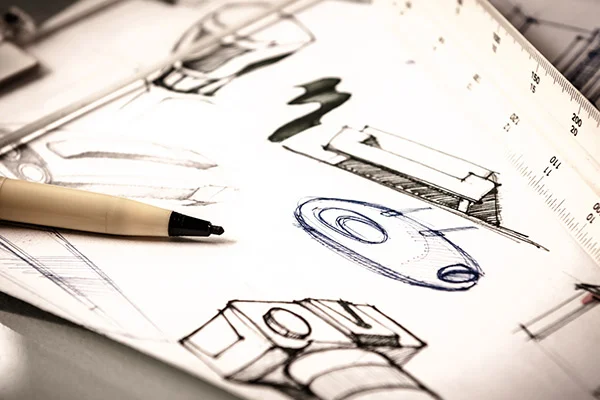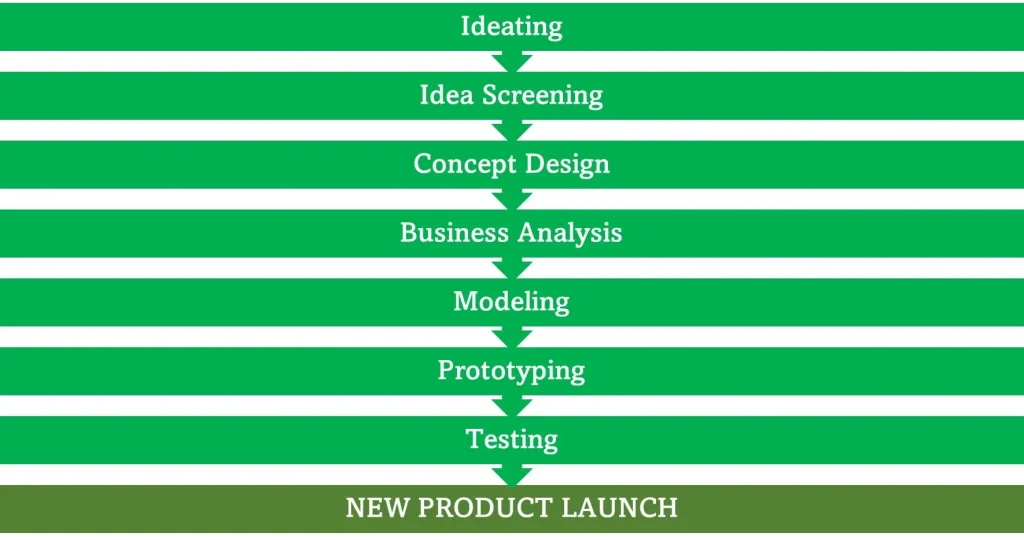8 Phases of New Product Development
- Home
- Blog Details

- August 12 2022
- admin
You are a seasoned design professional or a talented individual with a great idea and an impeccable design. But you don’t know how to push your idea to life. There are more foundational aspects to a great product, which finally work upon each other to build excellent output. To stay ahead of competitors and to changing market demands, companies need a continuous barrage of new ideas and designs which need to be converted into a tangible products. Success is the prime end game of this business; failure is a no-go zone, especially when odds are at stake against you. Errors and mistakes are unwelcomed in this game; hence there is a proven road for companies to consider when deciding on creating a new product.
This blueprint for a new product lays down a systematic, customer-driven new product development process that ensures an orderly progression, as shown below.

This section outlines and explores the various early stages of the industrial design process that a product goes through. It does serve as a reasonable account of the overall and general product design process.
Ideating or initial ideas
Before any design work can begin on a product, there must first be a definition of what the product or product line might be. It involves relentless brainstorming for a skeletal model keeping its usability, aesthetics, and target market in mind. The idea’s genesis can be due to many factors such as:
- Consumer demand – Reviews & feedback from the customers or even their ideas can help companies generate new product ideas.
- Internal sources – Companies provide incentives and perks to employees who come up with new product ideas.
- Market research – Companies constantly review the market’s changing needs, requirements, and trends by conducting a plethora of market research analyses.
- Competition – Competitors’ SWOT analysis helps companies to generate ideas.
Idea screening
An idea can be excellent, good, moderate, or very bad. Once a suitable product opportunity has been identified, a specification document or design brief is created to define the product. It is usually made by a company’s higher management, who’ll have access to information, such as budgeting and buyer/seller feedback. This step involves filtering out the reasonable and feasible ideas which maintain the technical integrity while staying within realistic cost expectations.
Features such as a mechanical specification or a reference to an existing invention the product might be based upon are outlined. Expectations uses and underlying intelligence associated with the product are also included. Electronics may also be mentioned, including sounds, lights, sensors, and other specific inputs, such as colors and new materials. Finally, a few reference sketches or photo images can be added to convey a possible direction.
Concept design & development
All ideas that pass through the screening stage are turned into concepts for testing purposes. A concept is a detailed strategy or blueprint version of the idea. In most companies, designers work up a design brief or product specification that guides their designs. It’s the designer’s role to make these ideas a reality. A professional designer can provide a large variety of designs quickly and efficiently. Many people can draw one or two ideas, but when asked to elaborate, they often fall short. What separates the true design professional is the depth and breadth of their presented ideas and vision clearly and concisely. Concept design generally means using hand-drawn or digital sketches to convey what’s in a designer’s mind onto paper or a screen.
Business analysis
Once the company has finalized the product outline and marketing strategy, it has to conduct a business evaluation to assess the alluring factor of the proposed new product. It requires a business analysis that involves sales, costs, and profit projections to find the potential success of the new product. Detailed business analysis is needed to determine the feasibility of the product. This stage determines whether the product is commercially profitable or not, whether it will have a regular or seasonal demand and the possibility of it being in the market for the long run. Companies look into sales history, analyze changing market trends, and study target market demands to ascertain a probable demand forecast for the product. Keep in mind that customer perspective and feedback is essential than a company’s perspective of the product.
Modeling
With the help of 3D modeling software (CAD – Computer Aided Design), the ideas/concept is rendered a shape, thereby creating a 3D model. The technical and engineering team has the biggest workload during this phase. These 3D models will often show problematic areas where the theoretical stresses and strains on the product to be developed will be exposed. If any problem persists, it is the best phase of product development to handle the design errors and devise modifications to address them.
Prototyping & pilot runs (preliminary design stage)
In this stage, prototypes are built and tested after several iterations, and a pilot run of the manufacturing process is conducted. This stage involves creating rapid prototypes for a concept deemed to have business relevance and value. Prototype means a ‘quick and dirty’ model rather than a refined one that will be tested and marketed later. Adjustments are carried out as required before finalizing the design.
Test marketing
Apart from continuously testing the product for performance, market testing is also carried out to check the acceptability of the product in the defined market and customer group. It is usually performed by introducing the new product on a very small scale to check if there are any shortcomings. It helps to know in advance whether the customer will accept and buy this product on launching in the market. Test marketing is a powerful tool indeed.
New product launch
This is the final stage in which the product is introduced to the target market. Production starts at a relatively low volume level as the company develops confidence in its ability to execute production consistently and market abilities to sell the product. Product manufacturing expenses depend on the product’s density if there are numerous parts, material selection, etc. The organization must equip its sales and customer service entities to address and handle queries. Product advertisements, website pages, press releases, and e-mail communications are kept on standby on the launching day.
Difference between New Product Development & Industrial Design
Let us take a step back and walk through the definitions presented in this article.
| New Product Development | Industrial Design |
| The process involves strategizing, creating requirements, generating concepts, creating product & marketing plans, evaluating market & consumer trends, and subsequent commercialization, and product improvement, thus bringing a new product to the marketplace | Industrial Product Design is the practice of forming concepts and designing products, which are to be manufactured through techniques of mass production |
| Product development is a complete cycle that starts from market analysis and product specifications to the concept/industrial design, costing, scheduling , testing, and manufacturing and ends at logistics, customer feedback, improvements, and the final act of getting a product into the market | Product Design is a complete process that includes industrial product design, user experience, 3D Cad modeling, design calculations, and simulation. A good product design’s responsibility is to make the product work as per design specifications. It is a crucial subset of NPD necessary to successfully complete the entire development cycle. |
Product development is an ever-evolving fluid process and cannot be summed up in a few steps. The entire procedure sees the insertion of additional stages or even eviction of a crucial part, depending on the nature of the project. Each group of professionals, whether designers, engineers, or marketing or sales, has its role in this methodology. It is the company’s responsibility to monitor the new product’s performance continuously.

